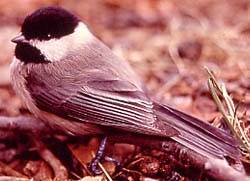Black-capped Chickadee
|
|
| Black-capped Chickadee | ||||||||||||||
|---|---|---|---|---|---|---|---|---|---|---|---|---|---|---|
 | ||||||||||||||
| Scientific classification | ||||||||||||||
| ||||||||||||||
| Binomial name | ||||||||||||||
| Parus atricapillus Linnaeus, 1766 Template:Taxobox begin synonyms Template:Taxobox synonym entry simple Template:Taxobox end synonyms |
The Black-capped Chickadee, Parus atricapillus or Poecile atricapilla, is a small songbird.
Adults have a black cap and bib with white sides to the face. Their underparts are white with rusty brown on the flanks; their back is grey. They have a short dark bill, short wings and a long tail.
Their breeding habitat is mixed or deciduous woods in Canada, Alaska and the northern United States. They nest in a hole in a tree; the pair excavates the nest, using a natural cavity or sometimes an old woodpecker nest. They may interbreed with Carolina Chickadees or Mountain Chickadees where their ranges overlap.
They are permanent residents, but sometimes move south within their range in winter. On cold winter nights, these birds reduce their body temperature to conserve energy.
Black_capped_chickadee_cp.jpg
These birds hop along tree branches searching for food, sometimes hanging upside down or hovering; they may make short flights to catch insects in the air. Insects form a large part of their diet, especially in summer; seeds and berries become important in winter. They sometimes hammer seeds on a tree or shrub to open them; they also will store seeds for later use.
During the fall migration and winter, chickadees often flock together. Many other species of birds, including titmice, nuthatches, and warblers can often be found foraging in these flocks. The reason this mixed flock stays together because the chickadees call out whenever they find a good source of food. Communication forms cohesion for the group, because they find food more efficiently by calling out.
The call is the familiar chick-a-dee-dee-dee which gave this bird its name.
This is the provincial bird of New Brunswick and the state bird of Maine and Massachusetts.
Taxonomic note: Most authorities retain Poecile as a subgenus within a broader view of the genus Parus, but the American Ornithologists' Union treats Poecile as a distinct genus.
